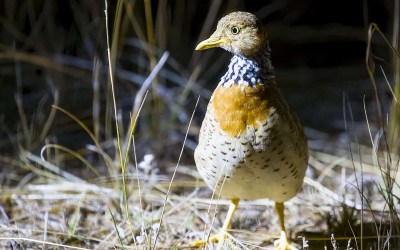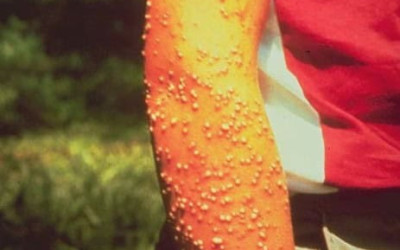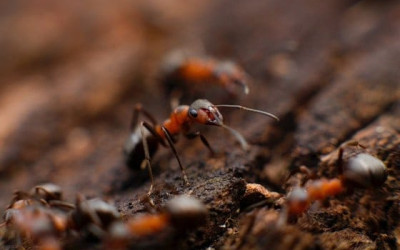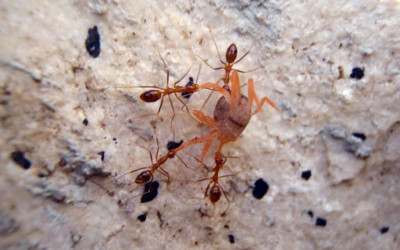MEET THE INVADERS
Fire ants
Red imported fire ants (Solenopsis invicta) may be small – measuring just 2–6 mm – but don’t let their size fool you.
These tiny killers are highly resilient, capable of enduring both drought and flood.
As omnivores, they are able to eat plants, honeydew, insects and other small animals and can live in many different habitats – beaches, grasslands and woodlands, on farms and in towns.
Their colonies can range from a few hundred thousand to millions of ants, with some colonies having multiple queens. In certain conditions, they can form interconnected, cooperative colonies, known as super colonies, that function as a single massive population.
Whether for mating – fertile fire ants can fly up to 5 kilometres – or by budding, where reproductive ants move short distances to form dense clusters, fire ants are relentless in their pursuit of new territory. Human activity also plays a role – as the tiny killers hitchhike in materials carried from one place to another.
If that wasn’t enough, they can also form rafts to float across water by linking their bodies together, allowing them to survive floods and continue their spread.
But what truly sets fire ants apart is their collaborative behaviour when attacking for defence or foraging. When feeling threatened, hundreds may swarm and sting in unison, coordinated by pheromones – a response not seen in other ant species. By biting to get a grip and then repeatedly stinging to inject a potent venom consisting of dozens of different chemicals, they are able to overwhelm much larger animals, including humans.
In their native South America, fire ant populations are regulated by natural predators like armadillos, as well as parasites and diseases. Fish nibble at rafting clusters from beneath the water and competing ant species, like the tawny crazy ant, also reduce their numbers.
Australia’s climate and lack of predators make it the perfect home for these invaders.
Invasion story
Fire ants were first detected in Australia in 2001 at the Port of Brisbane, Queensland, marking the start of Australia’s battle with this super pest. They may have been there for a decade or more before being noticed.
How fire ants first arrived in Australia remains uncertain, but it was probably with shipping containers from America. Imported cargo is a fire ant’s perfect hitchhiking opportunity and can easily go unnoticed.
By 2005, the port infestation had been eradicated. However, this was just the beginning.
Also in 2001, another incursion was discovered in Richlands and Wacol, suburbs in south-west Brisbane. This one has proved much more difficult to eliminate.
Several other smaller outbreaks occurred in the years following – all linked to ports and airports – including in Gladstone (2006, 2013), the Port of Botany in Sydney (2014), Brisbane Airport (2015), Port of Brisbane (2016), and the Port of Fremantle in Western Australia (2019). Following successful eradication programs these areas are now fire-ant-free.
However, the south-east invasion continued. Underfunded control work slowed its spread but failed to eradicate the fire ant stronghold. By 2023, it had spread to over 850,000 hectares of land, including residential areas, farmlands and native landscapes.
Then came an incursion on Minjerribah (North Stradbroke Island) – a devastating blow to a fragile, recovering landscape. The island has been the site of a major restoration project following decades of sand mining, with native vegetation slowly reclaiming the land. But in late 2023, a huge infestation of fire ants were discovered, threatening years of progress for the island’s recovering native species.
In the same year, at least 5 nests were detected 13 km south of the Queensland border in South Murwillumbah, New South Wales. A second detection was made in Wardell in January 2024 and in Clunes in November 2024. These nests have since been destroyed.
Today, a suppression zone has been established in south east Queensland which covers the edges of the infestation area. However, delays in eradication efforts have allowed fire ants to grow in both density and range within the core infestation zone, making the challenge of complete eradication even more complex.
‘The cost of fire ants in the US is calculated in the billions, not millions. There are costs to ranchers, livestock costs, equipment damage, they invade aircon units and pump houses, electrical switch boxes, you name it...sometimes people need to experience fire ants to take them seriously, but by the time you experience it, it will be too late. ‘The only thing holding back eradication in Australia seems to be willingness and resources.’
US fire ant expert Dr Robert Puckett Tweet
How did we get here?
Shockingly, all of this could have been prevented.
In 2003, the south east Queensland infestation was almost eradicated.
But early success bred complacency. Premature declarations of success, funding cuts between 2005 and 2017 and a failure to fully map the infestation allowed fire ants to spread unseen. Their expansion was slow during dry years – until the devastating 2011 floods and following wet seasons supercharged their growth.
In 2017, the Australian National Fire Ant Eradication Program (NRIFAEP) was launched, receiving $411 million in funding.
A comprehensive government study from 2021 found that between $200 and $300 million annually would be required over the next 10 years or Australia would face at least a $2 billion cost per year from fire ants, forever.
Following significant advocacy efforts, in late 2023 an additional $593 million eradication funding was confirmed until 2027. But it’s still not enough to achieve full eradication.
The toll on nature
Fire ants are rightly considered a super-pest globally, causing high, long-term environmental, public health, agricultural and economic costs in countries they invade.
Australia is not immune.
Fire ants heavily impact ants and other insects. They swarm and kill wildlife, especially those with open habitats and small distributions, such as critically endangered earless dragons and plains wanderers.
Turtle and ground-nesting bird populations are also at risk as fire ants significantly reduce hatchling survival. Analysis from the Commonwealth Environment Department found iconic Australian species like koalas, echidnas, platypus and turtles all have the potential to injured, or even killed by fire ants.
An assessment of their likely impact on 123 animals in south east Queensland predicts population declines in 45% of birds, 38% of mammals, 69% of reptiles and 95% of frogs.
There is also grave concern about their potential to invade protected areas including those of the Gondwana Rainforests World Heritage Area.
But it’s not just our wildlife that will suffer, it’s humans too! Painful stings and pustules impact humans and their pets who come into contact with fire ants. The Australasian Society of Clinical Immunology and Allergy found that anaphylaxis rates are almost 3 times more common from fire ants than from other stinging insects. This is because of their population density and their aggressive swarming responses.
To put this into perspective, bee stings alone caused 12 fatalities in Australia in 2021.
In the southern part of the United States, a place which has lost its battle with these super pests, around $8.75 billion USD is spent annually on medical treatment and control in infested areas.



How do we fix this?
Despite being underfunded, Australia’s fire ant eradication program has already achieved much, including the world’s largest invasive ant eradication.
In Queensland, fire ant detection methods include aerial imagery, ground searching with detector dogs, and visual inspections conducted by fire ant program officers. These approaches are critical for locating colonies, particularly in hard-to-reach areas.
Once colonies are identified, fire ant baits are used – currently the most targeted and effective treatment. This bait is designed to exploit the ants’ foraging behaviours. Worker ants carry the bait back to their colonies, where it renders the queen infertile, leading to the eventual collapse of the colony. This approach has the lowest environmental impacts of all fire ant treatments including those used in other countries.
Identifying and closing off pathways for fire ant arrivals and spread in Australia is crucial if we are to be successful. Unfortunately, many incursions are still not detected until years after they arrive. In fact, many are also discovered by chance rather than through systematic surveillance.
In 2024, the Australian Senate fire ant inquiry provided 10 recommendations to get fire ant eradication efforts back on track. These include a funding review, a long-term funding commitment, greater transparency, research and a new independent eradication authority.
As one of the only environmental organisations playing an active role in the fight against fire ants, the Invasive Species Council continues to push for sustained, long-term funding to ensure Australia’s fire ant-free future. We also urge the Australian Government to rapidly implement the senate inquiry findings.
FAQs
Fire ants are a significant threat to native wildlife, agriculture and human health. They could cause major declines in many native species Their stings cause painful reactions and, in some cases, can be fatal. They also destroy crops and are a significant burden on farmers and the economy.
Fire ants are native to South America and were likely introduced to Australia through global trade. Their aggressive nature and ability to form large colonies have allowed them to spread rapidly throughout Queensland and northern New South Wales.
The effort to eradicate fire ants is being funded by all federal, state and territory governments and managed by the Queensland Government. To achieve eradication every property in the eradication zone in south-east Queensland must be treated and checked. The Invasive Species Council continues to advocate for sustained funding and more research into effective control methods.
You can help by raising awareness in your community and supporting government action on fire ant eradication. Small changes, like checking your property for infestations can help stop the spread.
Invasive Species Council. (2024). Fact sheet: Red fire ants. Retrieved from https://invasives.org.au/wp-content/uploads/2024/05/Fact-Sheet-Red-Fire-Ants.pdf
Fire Ants Australia. (n.d.). Fire ants: Behaviour. Retrieved from https://www.fireants.org.au/look/biology/behaviour
Fire Ants Australia. (n.d.). How fire ants arrived in Australia. Retrieved from https://www.fireants.org.au/stop/how-fire-ants-arrived-in-australia
Queensland Audit Office (QAO). (2023). Managing invasive species (Report 1 – 2023–24). Retrieved from https://www.qao.qld.gov.au/sites/default/files/2023-07/Managing%20invasive%20species%20%28Report%201%20%E2%80%93%202023%E2%80%9324%29.pdf
New South Wales Department of Primary Industries (DPI). (n.d.). Red imported fire ants (RIFA). Retrieved from https://www.dpi.nsw.gov.au/dpi/bfs/insect-pests/rifa
U.S. Department of Agriculture (USDA). (2023). Imported fire ant and household insects research: 2023 annual report. Retrieved from https://www.ars.usda.gov/research/project/?accnNo=436291&fy=2023
The Australia Institute, Fire ants report, retrieved from https://australiainstitute.org.au/wp-content/uploads/2024/04/The-Australia-Institute-Fire-Ants-Report.pdf.
Fire Ants Australia. Economic impact of fire ants. Retrieved from https://www.fireants.org.au/dangers/impacts/economy#:~:text=Fire%20ants%20have%20the%20potential,industries%2C%20making%20popular%20destinations%20unattractive
Ant Pests, Natural enemies of fire ants, Ant Pests Extension, viewed 4 April 2025, https://ant-pests.extension.org/natural-enemies-of-fire-ants/.
Invasive Species Council. (2024). Fact sheet: Red fire ants. Retrieved from https://invasives.org.au/wp-content/uploads/2024/05/Fact-Sheet-Red-Fire-Ants.pdf
Fire Ants Australia. (n.d.). Fire ants: Behaviour. Retrieved from https://www.fireants.org.au/look/biology/behaviour
Fire Ants Australia. (n.d.). How fire ants arrived in Australia. Retrieved from https://www.fireants.org.au/stop/how-fire-ants-arrived-in-australia
Queensland Audit Office (QAO). (2023). Managing invasive species (Report 1 – 2023–24). Retrieved from https://www.qao.qld.gov.au/sites/default/files/2023-07/Managing%20invasive%20species%20%28Report%201%20%E2%80%93%202023%E2%80%9324%29.pdf
New South Wales Department of Primary Industries (DPI). (n.d.). Red imported fire ants (RIFA). Retrieved from https://www.dpi.nsw.gov.au/dpi/bfs/insect-pests/rifa
U.S. Department of Agriculture (USDA). (2023). Imported fire ant and household insects research: 2023 annual report. Retrieved from https://www.ars.usda.gov/research/project/?accnNo=436291&fy=2023
The Australia Institute, Fire ants report, retrieved from https://australiainstitute.org.au/wp-content/uploads/2024/04/The-Australia-Institute-Fire-Ants-Report.pdf.
Fire Ants Australia. Economic impact of fire ants. Retrieved from https://www.fireants.org.au/dangers/impacts/economy#:~:text=Fire%20ants%20have%20the%20potential,industries%2C%20making%20popular%20destinations%20unattractive
Ant Pests, Natural enemies of fire ants, Ant Pests Extension, viewed 4 April 2025, https://ant-pests.extension.org/natural-enemies-of-fire-ants/.








